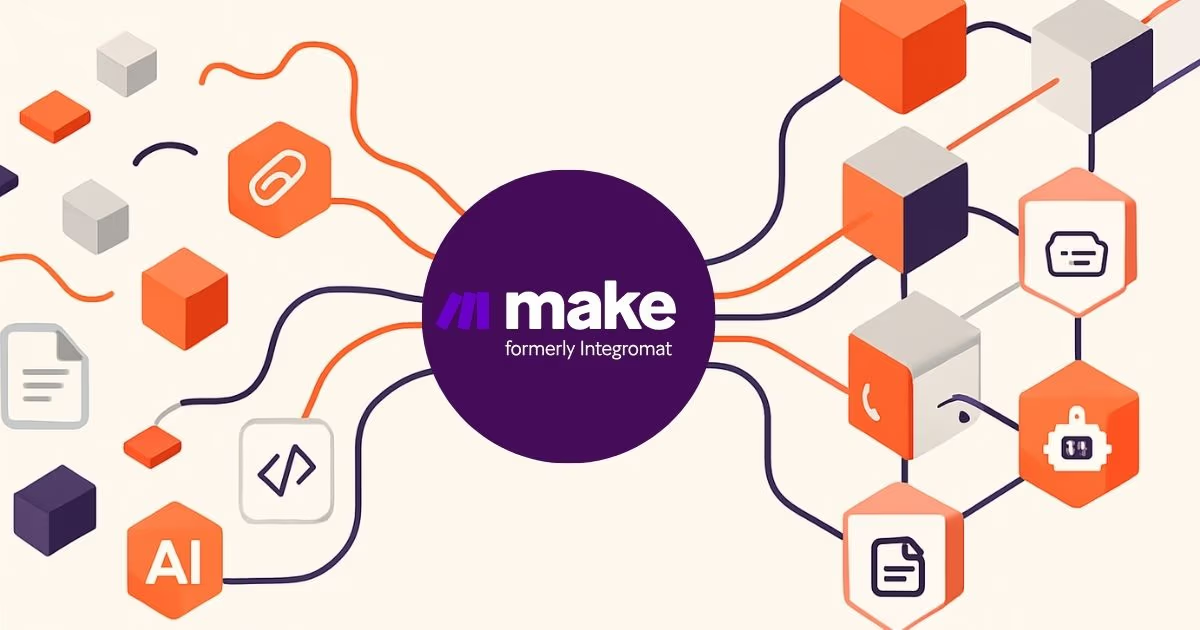Ok, we have to declare a bias. We use Make.com a lot, and here is why.
Make.com is a no-code development platform that enables users to visually create, build, and automate complex workflows without programming knowledge.
As soon as you want or need to orchestrate more complex automation, I mean that the automation itself adds value rather than just moves data, as many of the more ‘point and click’ automation tools tend to fall short. We are not saying don't use them, but be aware of what they are best used for.
We use the word orchestration for Make.com because, in our view, the most value is when you orchestrate processes and automation that improve information and knowledge exchange, whether that’s helping editors surface internal links, generating first-draft visuals with AI, or running a personalised content engine. What we love is that its visual interface still makes it accessible to non-developers, making it ideal for small teams digitising their event operations.
The most interesting orchestrations always add value to a process. For example, it can help editors find places to add existing content for internal links or automate the initial image generation process.
The Vidoe Above Shows How We Used Make to Automate All Our Meeting Action Items
As an aside, having tried many integration platforms, Zapier is characterised by its intuitive design, user-friendliness, and accessibility for individuals without deep technical expertise. This ease of use makes it popular for simple to moderately complex automation. At the opposite end of the spectrum, orchestration platforms like n8n are heavily geared towards developers, offering extensive control and customisation through visual code-based workflows.
In our view, Make.com sits between these two poles. While its interface occasionally presents a steeper learning curve than Zapier's, its visual flow builder offers a great way to understand, manage, and maintain complex processes.
And yes, Make.com can do a lot more. We've used it in dozens of ways, from automating podcast-to-article workflows to coordinating GPT agents. But what matters most in Digitising Events is this: Make lets you move from isolated automation to connected systems that improve how information flows, knowledge is applied, and intelligence emerges across your events.
Key Advantages:
- Visual workflow design with an intuitive interface
- Ability to orchestrate complex multi-app processes
- Trusted by 200,000+ customers across various industries
- Scalable automation that grows with your event needs
- Maintain one agent across multiple scenarios
- Over 2,000 App integrations
Make.com can take transcripts from a webinar, route them through multiple GPTs, and output a first draft article tailored to your audience, dramatically reducing production time while improving consistency.
Internal linking as a smart, scalable process
By combining Make.com with embeddings, your team can automatically identify where past content should be linked, increasing relevance and participant engagement while reducing editorial strain.

Multi-agent orchestration
Make.com makes it easy to chain together different AI models — e.g. Perplexity for research, GPT-4 for framing, and Gemini for insight extraction — all in one seamless workflow that feeds your Digitising Events engine.
Personalised session recommendations at scale
Using Make.com to retrieve embeddings and behavioural data from BigQuery, you can build custom workflows that push relevant sessions to individual participants based on real-time interest patterns.
Other Tips
If you decide to use Make.com, we recommend upgrading to one of the higher plans. This gives you access to variables in your scenario, which is incredibly useful.
The other helpful feature upgraded plans offer is the concept of ‘Teams’, which is an excellent way of keeping automation related to one event or your webinars in separate ‘spaces’. We found it very useful for staying organised.



